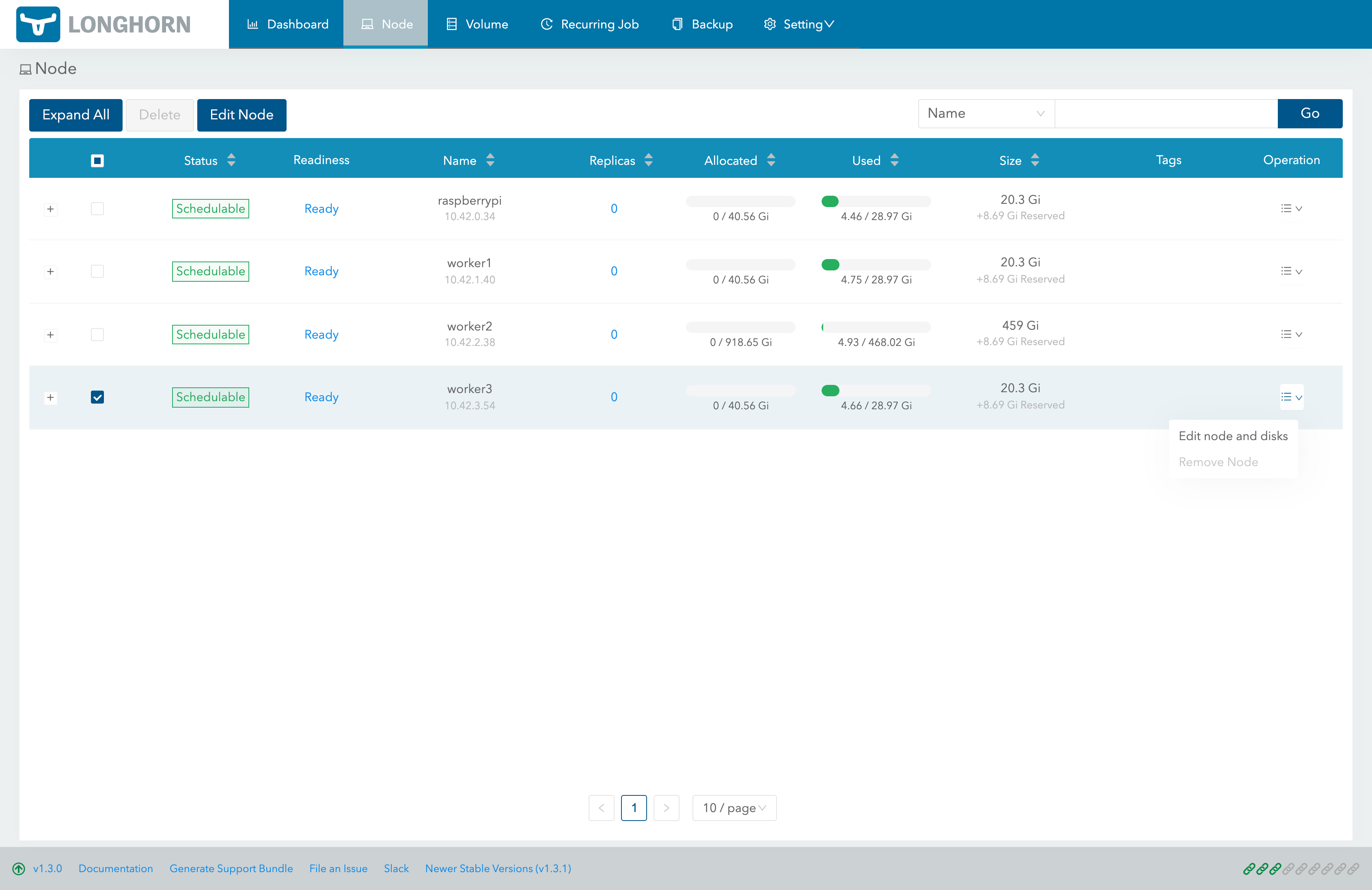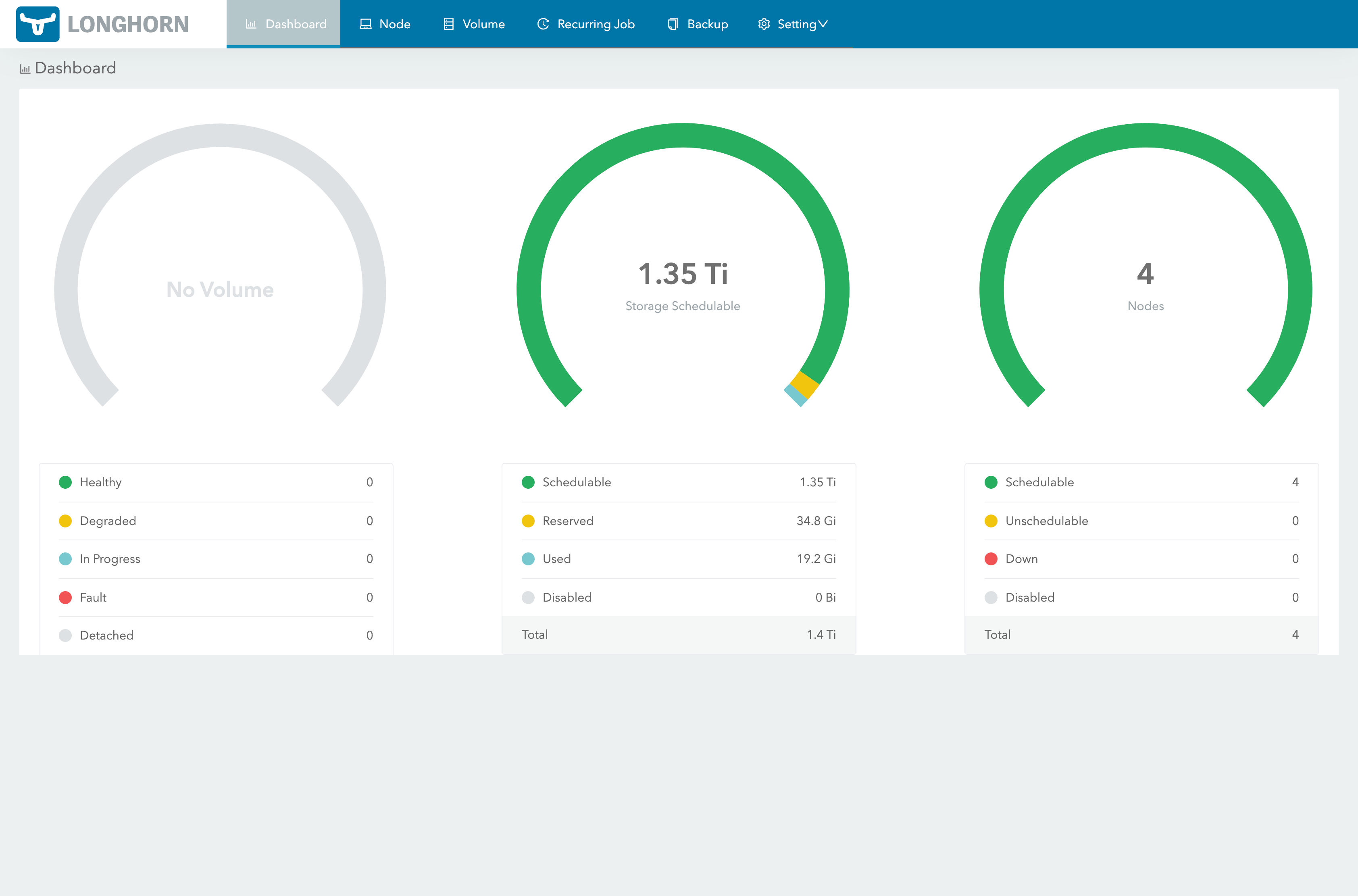Install Longhorn to manage volumes
Longhorn is an application to manage highly available persistent storage for Kubernetes. It can also create easily incremental snapshots and backups.
As your cluster is bare-metal, you need an application to manage the volumes and Longhorn is the easiest solution.
Add the application with Lizz
Add Longhorn to your cluster with Lizz using the following command:
lizz add github \
--owner=$GITHUB_ORG \
--fleet=fleet \
--origin-url=https://github.com/openlizz/application-longhorn \
--path=./default \
--destination=longhorn \
--cluster-role
Reconcile the fleet repository with Flux to deploy the application in the cluster:
flux reconcile source git flux-system
Check that the pods are ready with the following command:
kubectl -n longhorn-system get pods
After a couple of minutes, the output should be similar to:
NAME READY STATUS RESTARTS AGE
longhorn-conversion-webhook-74679ff5cb-g8z8z 1/1 Running 0 33m
longhorn-conversion-webhook-74679ff5cb-fzbwp 1/1 Running 0 33m
longhorn-ui-5c5dfcf6f9-bc7jn 1/1 Running 0 33m
longhorn-admission-webhook-77795bf954-58lk4 1/1 Running 0 33m
longhorn-admission-webhook-77795bf954-nlj6k 1/1 Running 0 33m
instance-manager-e-ac823c7d 1/1 Running 0 32m
instance-manager-r-471404dd 1/1 Running 0 32m
longhorn-manager-kz6dg 1/1 Running 0 33m
longhorn-manager-lk7fd 1/1 Running 0 33m
longhorn-manager-5p9cq 1/1 Running 1 (32m ago) 33m
longhorn-manager-7zg9x 1/1 Running 1 (32m ago) 33m
instance-manager-r-a3d6577b 1/1 Running 0 32m
instance-manager-e-5767282f 1/1 Running 0 32m
instance-manager-r-9a39569b 1/1 Running 0 32m
instance-manager-e-a77ad366 1/1 Running 0 32m
longhorn-driver-deployer-6676887758-lvz4v 1/1 Running 0 33m
instance-manager-r-575a9609 1/1 Running 0 32m
instance-manager-e-b53afa1f 1/1 Running 0 32m
engine-image-ei-df38d2e5-h86v7 1/1 Running 0 32m
engine-image-ei-df38d2e5-bckff 1/1 Running 0 32m
engine-image-ei-df38d2e5-z8xcc 1/1 Running 0 32m
engine-image-ei-df38d2e5-ggnh9 1/1 Running 0 32m
csi-resizer-7c5bb5fd65-zjsn8 1/1 Running 0 32m
csi-resizer-7c5bb5fd65-2g88g 1/1 Running 0 32m
csi-attacher-dcb85d774-b6w7w 1/1 Running 0 32m
csi-provisioner-5d8dd96b57-7z78z 1/1 Running 0 32m
longhorn-csi-plugin-9278b 2/2 Running 0 32m
longhorn-csi-plugin-d7d4n 2/2 Running 0 32m
csi-snapshotter-5586bc7c79-4zntq 1/1 Running 0 32m
csi-snapshotter-5586bc7c79-pdqlv 1/1 Running 0 32m
csi-snapshotter-5586bc7c79-ktjkl 1/1 Running 0 32m
csi-attacher-dcb85d774-kxkvc 1/1 Running 0 32m
csi-provisioner-5d8dd96b57-9hkr5 1/1 Running 0 32m
csi-resizer-7c5bb5fd65-q75gd 1/1 Running 0 32m
longhorn-csi-plugin-p5dcw 2/2 Running 0 32m
longhorn-csi-plugin-b4kpd 2/2 Running 0 32m
csi-provisioner-5d8dd96b57-hv5mh 1/1 Running 0 32m
csi-attacher-dcb85d774-4wzqv 1/1 Running 0 32m
Configure Longhorn to add SSDs
You can access the Longhorn frontend using port-forwarding:
kubectl -n longhorn-system port-forward svc/longhorn-frontend 8000:80
The Longhorn frontend should be accessible at http://localhost:8000/. You can now configure Longhorn by adding the SSDs to the nodes:



Change Kubernetes storage class
By default, K3s uses local path as default Kubernetes storage class. With Longhorn installed, a new default storage class has been created. You can check it by running:
kubectl get storageclass
The output should be similar to:
NAME PROVISIONER RECLAIMPOLICY VOLUMEBINDINGMODE ALLOWVOLUMEEXPANSION AGE
local-path (default) rancher.io/local-path Delete WaitForFirstConsumer false 20h
longhorn (default) driver.longhorn.io Delete Immediate true 116m
Because it is not possible to have two default storage classes and you want Longhorn being the default one, mark the local-path storage class as non-default (update the name of the storage class if this is not local-path):
kubectl patch storageclass local-path -p '{"metadata": {"annotations":{"storageclass.kubernetes.io/is-default-class":"false"}}}'
Now when running:
kubectl get storageclass
The output should be similar to the following with longhorn being the only default storage class:
NAME PROVISIONER RECLAIMPOLICY VOLUMEBINDINGMODE ALLOWVOLUMEEXPANSION AGE
longhorn (default) driver.longhorn.io Delete Immediate true 116m
local-path rancher.io/local-path Delete WaitForFirstConsumer false 20h